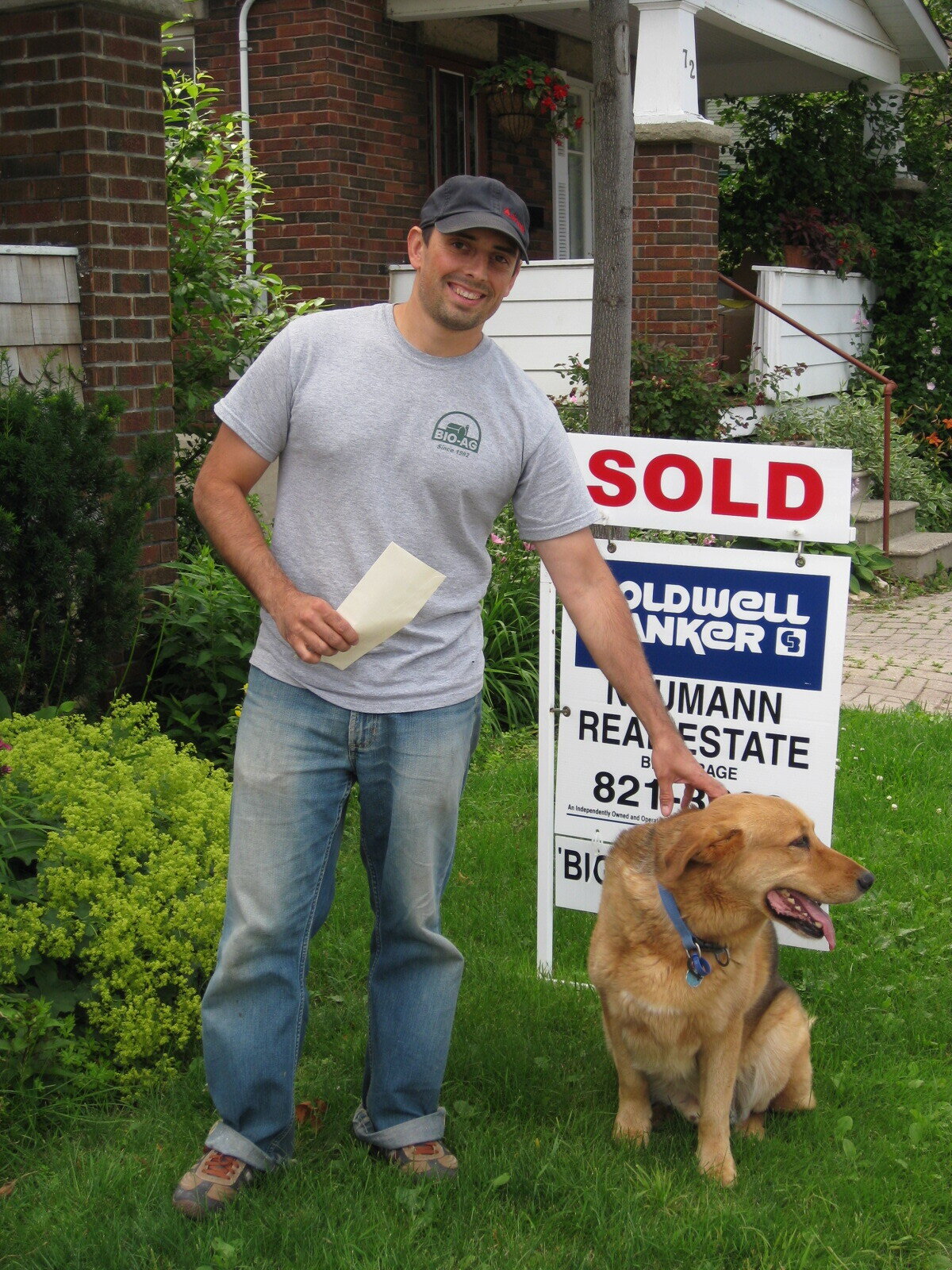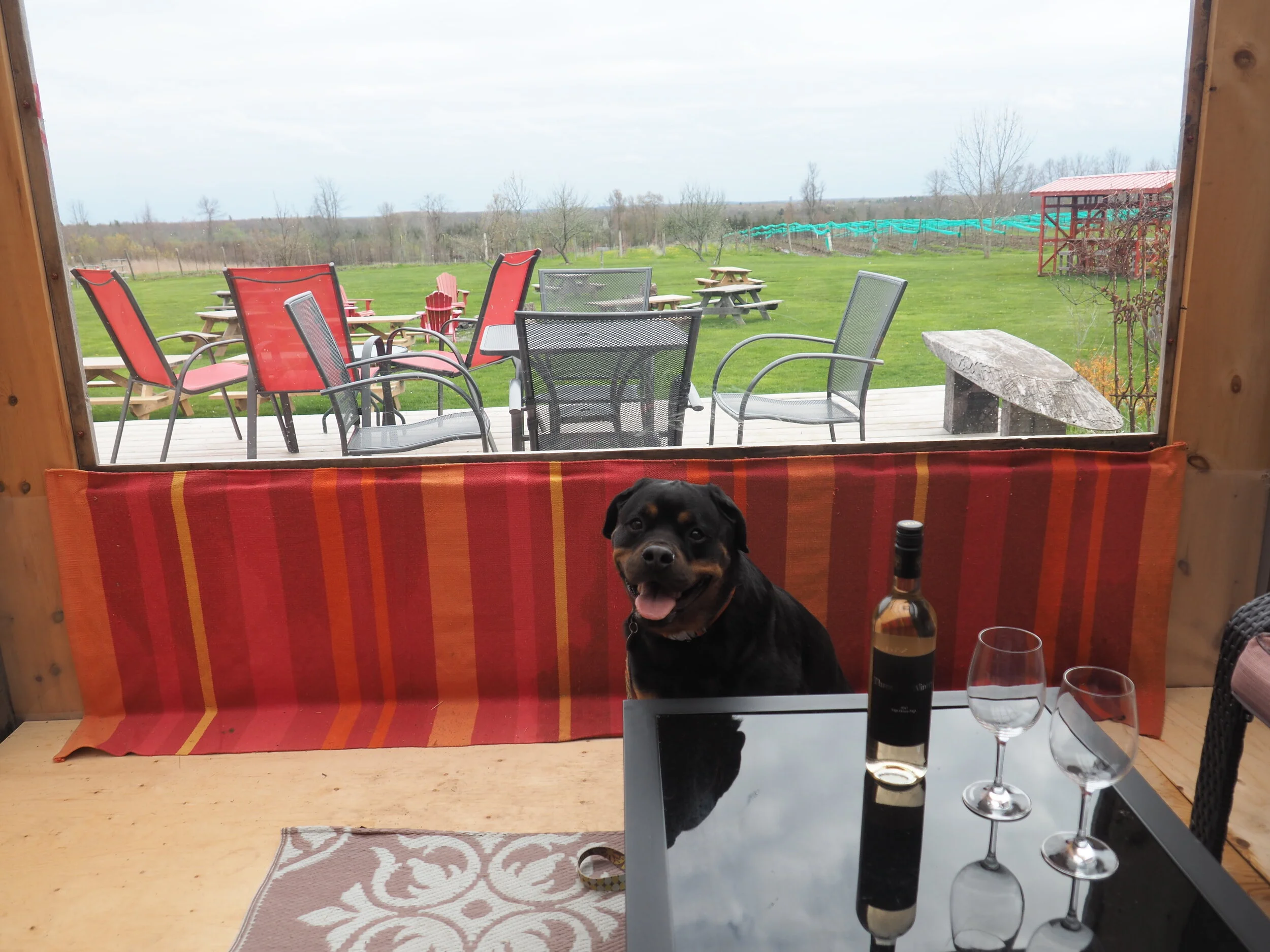If your new rescue dog has behavioural issues, get them help early. Don’t wait! (Photo: Pomeranian with whale eye)
Your new rescue dog is an absolute sweetheart! She sat in the backseat with your kids the whole way home, she walks pretty well on the leash, and shows no interest in squirrels.
The foster family said she’s great around food, bones, and toys. They told you she loves dogs, cats, and strangers.
She seems a little fearful of your cats. You film a video of her hiding behind your legs when the cats walk by. That’s cute. Right?
The first day seems like a dream. Until you walk her in the dark.
She seems terrified of the darkness, men, blowing leaves, and her own shadow. (Photo: Shiba Inu Husky Mix on a chain in the darkness)
At first, you think it’s nothing. “She’s a little velcro dog,” you think. “She loves me so much.” You smile.
As you approach a tall man in the darkness, she seems even more nervous. He moves over to give you more space. She lunges at him anyway and tries to nip his ankles.
“Sorry. She’s a rescue,” you say. He’s already gone. You add in the darkness, “I’ve only had her a couple of hours.”
You keep walking, but your heart is racing. Was she abused by a man before? She seemed fine with her foster “dad.” “She must have been abused before that,” you think.
The following day, she growls at your husband when he comes home from work.
You tell yourself, “She’s already protecting me. She loves me.” Secretly, you think, “I kind of like that she likes me more than my husband.”
If you’ve thought any one of those thoughts, you need to stop reading and call a behaviourist who understands dog psychology immediately. Right now. I wish I were joking. I have seen countless fearful rescue dogs become even more fearful and insecure by being secretly loved for being fearful and protective.
It is a dangerous and extremely slippery slope you are sliding down. It can lead to bites. It can lead to your dog refusing to allow strangers into the home (your family and friends + your children’s friends - these are strangers to your new dog.) It can lead to you giving the dog away to the humane society, or WORSE - it can lead to you having to euthanize your new dog because it bit a child in the face. I have seen all of this happen. It is heartbreaking!
If your dog bites your child you will be faced with a horrible dilemma (Photo: crying toddler reaches forward with outstretched hands)
Schedule a FREE 15 minute phone call with us TODAY if you are struggling with a fearful rescue dog.
The following day, your rescue dog is facing off with the dog who lives next door. They could wake the dead with their barking, snarling, and growling through the fence.
Fast forward a few more days and this sweet rescue that you brought home is now barking and lunging at your children’s friends as they race up the driveway and sprint through your house.
Inside the home, she’s no longer afraid of the cats, but chasing them.
She isn’t walking nicely on the leash anymore either. She’s pulling you every which way, not listening when you say “sit,” and when she’s not barking at other dogs, she’s whining.
Fast forward a few more days and your nine-year-old niece gets bitten while visiting your house.
A few days after that and you can’t hug your own children without the dog trying to bite them. Truth is stranger than fiction people. I’ve seen this happen too.
The best advice I can provide you with is that you should call for help NOW before you let these things happen. You have the chance right now to prevent these disasters from ever occurring.
Drop what you’re doing and search online for some help (Photo: woman perched on the bow of a sailboat with a laptop on her lap)
You may find solace in online dog groups. People will tell you that it’s only been a couple of days and to allow your dog time to settle in. This advice is terrible. It only takes one or two weeks for a new rescue dog to COMPLETELY take over your house. They will own your house, your yard, your children, and you. By the time you call someone for help, it will cost you more money and take more time to fix the issue.
What to do? Go online right now and search for dog behaviourists who have experience in this area. Read their Google Reviews. Read the testimonials on their website. And then CALL THEM. Interview them on the phone. Just because they helped your friend’s puppy in puppy class three years ago doesn’t mean they can help you in your home with your three-year-old rescue from the Bahamas who is biting and snapping at strangers.
One of my clients interviewed FIFTEEN behaviourists and trainers before finding me. I was the ONLY one who was honest with them about how long it might take them to reach their particular goal (their new rescue dog had gone for the throat of one of their other dogs, and they had removed that dog from their pack with hopes of reintroducing her at a later date.)
Every other trainer told them that they would be able to reunite the pack within a couple of hours!
Hours!
Even if YOU as a trainer or behaviourist could rehabilitate all three dogs in a couple of hours, you absolutely could NOT help the human family (and their cat) maintain what you had started. It takes time to teach. It takes time to learn.
What should you do now?
Breathe.
Your dog can sense your stress, but has no idea WHAT is causing it. So, if your cat strolls into the room and you hold your breath and imagine the dog tearing the cat into pieces, you will set the dog off on the cat. Dogs can’t rationalize. They can’t understand that you’re worried because of something they MIGHT do. They see that every time the cat comes near the human, the human gets tense and nervous. And then they help take care of the problem by not letting the cat near you. They do this with people too, so do your best not to tense up when your son’s friends arrive at the house.
Breathe.
You’ve done a wonderful thing. You’ve rescued a dog. So what if you don’t know how to make her stop growling at your friends. Hire someone who knows how to do that AND can teach YOU how to do it. Listen to everything they say and practice as much as they ask you to practice. You’ve got this!
You CAN do this! (Photo: woman smiling as she hangs out with a brown and white dog on leash,)
Will EVERY rescue dog be this fearful? No.
Will EVERY rescue dog completely take over your house? That depends. If you selected the correct energy level of dog (a dog that has an energy level that is the same or LESS than you and your family,) you fulfill THEIR needs before your own EVERY SINGLE DAY, and everyone in the house (including the children) is consistent with the dog’s rules and boundaries (AKA everyone in the family is a leader in the dog’s eyes) then no, the dog will not take the leadership role in your home.
Owning a dog is a lot of responsibility and a lot of work. Adopting a rescue dog with behavioural issues can be very rewarding, but it’s certainly more work for inexperienced owners. If you’re willing to learn about dog behaviour and put in the time, you can certainly become a knowledgable dog lover.
Just breathe.
And then call some behaviourists. I hope you call me!
Happy interviewing, Dog Leaders!
Alyssa
Photos by: Michelle Tresemer (Pomeranian with whale eye,) Tom Lowen Morales (Shiba Inu Husky Mix on a chain in the darkness,) Zach Kadolph (crying toddler reaches forward with outstretched hands,) Damir Spanic (woman perched on the bow of a sailboat with a laptop on her lap,) and Cassiano Psomas (woman smiling as she hangs out with a brown and white dog on leash.)






















































